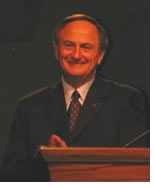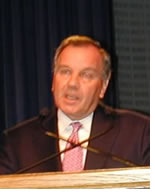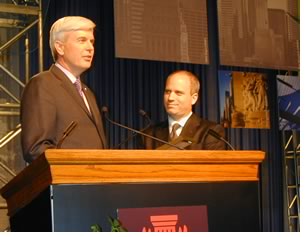

Architects Gather to
“Learn Celebrate Dream” in Convention’s Opening Session
Keynoter Larson recounts the White City’s
architectural legacy
 AIA
Executive Vice President/CEO Norman L. Koonce, FAIA, welcomed thousands
of architects, their friends, and colleagues to the 136th annual AIA National
Convention in Chicago June 10. Noting that the theme of the opening day
was “Learn,” Koonce said that 500 of the 1,025 architects
newly licensed in the past year had taken up the AIA’s offer of
complimentary registration to the convention. Moreover, he said, “young
and old, we have all come to Chicago to learn, and only through a culture
of sharing does true power unfold.” As we gather to learn from each
other and the great city of Chicago itself, Koonce invited all to consider
the AIA the “generator and wide open portal of knowledge.”
AIA
Executive Vice President/CEO Norman L. Koonce, FAIA, welcomed thousands
of architects, their friends, and colleagues to the 136th annual AIA National
Convention in Chicago June 10. Noting that the theme of the opening day
was “Learn,” Koonce said that 500 of the 1,025 architects
newly licensed in the past year had taken up the AIA’s offer of
complimentary registration to the convention. Moreover, he said, “young
and old, we have all come to Chicago to learn, and only through a culture
of sharing does true power unfold.” As we gather to learn from each
other and the great city of Chicago itself, Koonce invited all to consider
the AIA the “generator and wide open portal of knowledge.”
 Learn,
Celebrate, Dream
Learn,
Celebrate, Dream
AIA President Eugene C. Hopkins, FAIA, told the group that this year’s
convention theme, “Learn, Celebrate, Dream,” has almost become
a mantra for him through the event’s two years of preparation. As
Hopkins finds himself caught up in the convention’s “wonderful
gridlock of pumped-up architects,” Chicago is proving to be the
perfect setting for the theme. “Chicago makes the case for diversity,”
Hopkins said, citing the city’s wonderful architectural mix of Burnham,
Sullivan, Wright, Mies, and Jahn.
 The
greening of Chi-town
The
greening of Chi-town
“Welcome to our great city!” Chicago Mayor Richard M. Daley
told the architects. “We are a city that takes architecture seriously
… and we continue to push the envelope of architecture.” Daley
also expressed fondness for the diversity of Chicago’s architecture
and said that many of its faces were showing up in the city’s intensified
efforts to make itself the greenest city in the country. Elements of the
program include city grants to restore some 80,000 pre-WWII bungalows
with energy-sustaining strategies, and one million square feet of green
roofs, including the one on City Hall. The mayor explained that the strategies
all are part of Chicago’s new energy standards, certified by the
U.S. Green Buildings Council, in effect for all public buildings. He expressed
hope that private buildings will soon follow suit and thanked architects
for their “important role in shaping cities and determining quality
of life.” The audience responded to Mayor Daley’s remarks
with a standing ovation.
Honors
Mayor Daley also asked the audience for a moment of silence to honor former
President Ronald Reagan, who passed away June 5. Likewise, Hopkins asked
for a moment of silence to honor one of our own, 1989 AIA President Benjamin
E. Brewer Jr., FAIA, who passed away December 17, 2003.
 On
a happier note, Hopkins also presented a presidential citation to film
maker Nathaniel Kahn, in appreciation for his movie My
Architect: A Son’s Journey, which details his
quest to discover his father, Louis Kahn, through Lou’s magnificent
buildings. Of the film, Hopkins said, “it is not simply a love
letter; it is a moving, often funny embrace of the profession.”
Kahn expressed his great thanks for the honor and said that one of the
benefits of making My Architect was that he “got to learn a great
deal, including a little bit about what you do.” His father, he
said, “believed that architecture could change the world.”
And it’s true that what architects do “is so very important—you
create the foundation of the world.”
On
a happier note, Hopkins also presented a presidential citation to film
maker Nathaniel Kahn, in appreciation for his movie My
Architect: A Son’s Journey, which details his
quest to discover his father, Louis Kahn, through Lou’s magnificent
buildings. Of the film, Hopkins said, “it is not simply a love
letter; it is a moving, often funny embrace of the profession.”
Kahn expressed his great thanks for the honor and said that one of the
benefits of making My Architect was that he “got to learn a great
deal, including a little bit about what you do.” His father, he
said, “believed that architecture could change the world.”
And it’s true that what architects do “is so very important—you
create the foundation of the world.”
 President
Hopkins also had the privilege of presenting the
2004 Edward C. Kemper Award to Robert A. Odermatt, FAIA, The Odermatt
Group, Berkeley, Calif. The award, namesake of the first executive director
of the Institute, honors individuals who give outstanding service to the
profession through the AIA. Hopkins presented Odermatt as “a role
model for the profession.” Odermatt, in turn, expressed his gratitude,
saying he was “proud to be an architect and proud to be in Chicago,
celebrating our profession.” He thanked his many friends for this
special award from his peers and offered special gratitude to his wife,
Diana.
President
Hopkins also had the privilege of presenting the
2004 Edward C. Kemper Award to Robert A. Odermatt, FAIA, The Odermatt
Group, Berkeley, Calif. The award, namesake of the first executive director
of the Institute, honors individuals who give outstanding service to the
profession through the AIA. Hopkins presented Odermatt as “a role
model for the profession.” Odermatt, in turn, expressed his gratitude,
saying he was “proud to be an architect and proud to be in Chicago,
celebrating our profession.” He thanked his many friends for this
special award from his peers and offered special gratitude to his wife,
Diana.
Reflections of a White City
Norbert Young, FAIA, president of McGraw Hill Construction, sponsors of
the convention’s theme sessions, introduced keynote speaker Erik
Larson, known to many in the audience as author
of The Devil in the White City: Murder,
Magic, and Mayhem at the Fair That Changed America. Larson
transported the audience back to the turn of the century (the nineteenth
to twentieth century, that is), to the days of Daniel Burnham and friends
as they created the 1893 World Columbian Exposition in record time and
sometimes against incredible odds. (While the exposition is the “White
City,” the “Devil” in the book’s title refers
to H.H. Holmes, a serial murderer who used the world’s fair to lure
many of his victims to Chicago and his specially constructed hotel. Larson
tells the parallel tales of Holmes and Burnham as antipodes of the time.)
 Larson
made the audience laugh with irreverent tales of the many products that
came out of the exposition—from Juicy Fruit gum to zippers to Shredded
Wheat—as well as how the architects strove for a way to “out-Eiffel
Eiffel” by creating an engineering feat grander than the Eiffel
Tower, which graced the Paris Exposition a decade before. The hugely successful
solution proved to be George Washington Ferris’s 250-foot-tall Ferris
Wheel.
Larson
made the audience laugh with irreverent tales of the many products that
came out of the exposition—from Juicy Fruit gum to zippers to Shredded
Wheat—as well as how the architects strove for a way to “out-Eiffel
Eiffel” by creating an engineering feat grander than the Eiffel
Tower, which graced the Paris Exposition a decade before. The hugely successful
solution proved to be George Washington Ferris’s 250-foot-tall Ferris
Wheel.
Finally, the author put forth his take on the “Sullivan/Burnham controversy,” that is, Sullivan’s accusation that Burnham’s selection of the Classic style for the exposition would set “modern” architecture back for a century. Larson contended that it is odd that Sullivan took part in the design and did not protest the use of Classicism until years after the fair was over. Larson wondered if professional jealousy played a role in the accusation. If we follow Sullivan’s premise, he said, it means that it was the exposition’s great success that set architecture back, because people made some 28 million visits to take in its glory.
Larson claims instead that the exposition elevated interest in architecture among the public. Typically, the architectural Court of Honor was deemed the most striking feature of the fair. He reminded the audience that the World Columbian Exposition also paved the way for the City Beautiful Movement still influencing our urban centers today. Perhaps most noticeable, Larson concluded, is Chicago itself, where Burnham’s plan for the Lakeshore still reigns, and, in truth, “set cities forward for a hundred years.”
Copyright 2004 The American Institute of Architects.
All rights reserved. Home Page ![]()
![]()
 |
||
|
|
||